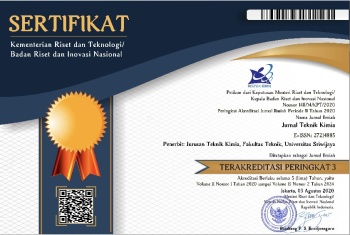Thermophysical and stability investigation of Al2O3- TiO2/water hybrid nanofluids
Abstract
Currently, one of the big challenges in the cooling systems technology is producing coolant fluid with good thermophysical dan stability properties. The new cooling fluids, namely nanofluid-based coolant has been developed for facing this challenge. Nanofluid is the dispersion of nanoparticle into base fluid. In this experimental investigation, thermophysical and stability of Al2O3-TiO2/Water hybrid nanofluid are studied. The Al2O3-TiO2/Water based hybrid nanofluid have been prepared by using two step method. The experiment is carried out for the various combination of volume fraction (0.2-0.6 wt%), ratio of nanoparticles (70:30-30:70wt%), stirring time (30-90 min), and sonication time (60-120 min). The thermophysical properties of the prepared nanofluids were characterized using pycnometer method for density and viscometer fall ball for viscosity. Photograph capturing method is applied to investigate the stability of nanofluids. According to the obtained results, the viscosity, density and stability have influenced by the synthesis parameters.
References
Bin Mahfouz, A., Ali, A., Mubashir, M., Hanbazazah, A. S., Alsaady, M., & Show, P. L. (2023). Optimization of viscosity of titania nanotubes ethylene glycol/water-based nanofluids using response surface methodology. Fuel, 347(January), 128334. https://doi.org/10.1016/j.fuel.2023.128334
Chamsa-ard, W., Brundavanam, S., Fung, C. C., Fawcett, D., & Poinern, G. (2017). Nanofluid types, their synthesis, properties and incorporation in direct solar thermal collectors: A review. In Nanomaterials (Vol. 7, Issue 6). https://doi.org/10.3390/nano7060131
Darminesh, S. P., Sidik, N. A. C., Najafi, G., Mamat, R., Ken, T. L., & Asako, Y. (2017). Recent development on biodegradable nanolubricant: A review. International Communications in Heat and Mass Transfer, 86, 159–165. https://doi.org/10.1016/j.icheatmasstransfer.2017.05.022
Giwa, S. O., Sharifpur, M., Ahmadi, M. H., Sohel Murshed, S. M., & Meyer, J. P. (2021). Experimental investigation on stability, viscosity, and electrical conductivity of water-based hybrid nanofluid of mwcnt-fe2o3. Nanomaterials, 11(1), 1–19. https://doi.org/10.3390/nano11010136
Gupta, M., Singh, V., Kumar, R., & Said, Z. (2017). A review on thermophysical properties of nanofluids and heat transfer applications. Renewable and Sustainable Energy Reviews, 74(December 2015), 638–670. https://doi.org/10.1016/j.rser.2017.02.073
Hamid, K. A., Azmi, W. H., Mamat, R., Usri, N. A., & Najafi, G. (2015). Effect of temperature on heat transfer coefficient of titanium dioxide in ethylene glycol-based nanofluid. Journal of Mechanical Engineering and Sciences, 8(June), 1367–1375. https://doi.org/10.15282/jmes.8.2015.11.0133
Huminic, G., & Huminic, A. (2018). Hybrid nanofluids for heat transfer applications – A state-of-the-art review. International Journal of Heat and Mass Transfer, 125, 82–103. https://doi.org/10.1016/j.ijheatmasstransfer.2018.04.059
Huminic, G., Huminic, A., Fleacă, C., Dumitrache, F., & Morjan, I. (2021). Experimental study on viscosity of water based Fe–Si hybrid nanofluids. Journal of Molecular Liquids, 321. https://doi.org/10.1016/j.molliq.2020.114938
Jose, J. V, Menon, A. V, & Sasi, S. (2015). Performance Analysis of Nanofluid Based Lubricant. International Journal of Innovative Research in Science, Engineering and Technology, 2013(1), 832–838.
Katpatal, D. C., Andhare, A. B., Padole, P. M., & Khedkar, R. S. (2017). Study of dispersion stability and thermo-physical properties of CuO-Jatropha oil-based nanolubricants. Journal of the Brazilian Society of Mechanical Sciences and Engineering, 39(9), 3657–3668. https://doi.org/10.1007/s40430-017-0856-z
Kedzierski, M. A., Brignoli, R., Quine, K. T., & Brown, J. S. (2016). Viscosity, Density, And Thermal Conductivity Of Aluminum Oxide And Zinc Oxide Nanolubricants. International Journal of Refrigeration. https://doi.org/10.1016/j.ijrefrig.2016.10.003
Kotia, A., Rajkhowa, P., Rao, G. S., & Ghosh, S. K. (2018). Thermophysical and tribological properties of nanolubricants: A review. Heat and Mass Transfer/Waerme- Und Stoffuebertragung, 54(11), 3493–3508. https://doi.org/10.1007/s00231-018-2351-1
Kumar, P. C. M., Palanisamy, K., & Vijayan, V. (2020). Materials Today : Proceedings Stability analysis of heat transfer hybrid / water nanofluids. Materials Today: Proceedings, 21, 708–712. https://doi.org/10.1016/j.matpr.2019.06.743
Ma, M., Zhai, Y., Yao, P., Li, Y., & Wang, H. (2021). Effect of surfactant on the rheological behavior and thermophysical properties of hybrid nanofluids. Powder Technology, 379, 373–383. https://doi.org/10.1016/j.powtec.2020.10.089
Mukesh Kumar, P. C., Palanisamy, K., & Vijayan, V. (2020). Stability analysis of heat transfer hybrid/water nanofluids. Materials Today: Proceedings, 21(xxxx), 708–712. https://doi.org/10.1016/j.matpr.2019.06.743
Oemar, B., Arifin, A., Bahrin, D., Astuti, Ramadhan, D., Rifqy, M. A., & Tinambunan, M. R. (2023). Experimental Investigation on Thermophysical and Stability Properties of TiO2/Virgin Coconut Oil Nanofluids. Science and Technology Indonesia, 8(2), 178–183. https://doi.org/10.26554/sti.2023.8.2.178-183
Sadiq, I. O., Sharif, S., Suhaimi, M. A., Yusof, N. M., Kim, D. W., & Park, K. H. (2018). Enhancement of thermo-physical and lubricating properties of SiC nanolubricants for machining operation. Procedia Manufacturing, 17, 166–173. https://doi.org/10.1016/j.promfg.2018.10.032
Su, Y., Gong, L., & Chen, D. (2016). Dispersion stability and thermophysical properties of environmentally friendly graphite oil-based nanofluids used in machining. Advances in Mechanical Engineering, 8(1), 1–11. https://doi.org/10.1177/1687814015627978
Yang, B., Shi, Y., Ma, X. Q., & Yu, X. H. (2023). Effects of mixed anionic/cationic surfactants on ZnO nanofluid. Journal of Molecular Liquids, 377, 121530. https://doi.org/10.1016/j.molliq.2023.121530
Zawawi, N. N. M., Azmi, W. H., Redhwan, A. A. M., Sharif, M. Z., & Samykano, M. (2018). Experimental investigation on thermo-physical properties of metal oxide composite nanolubricants. International Journal of Refrigeration, 89, 11–21. https://doi.org/10.1016/j.ijrefrig.2018.01.015

This work is licensed under a Creative Commons Attribution 4.0 International License.










